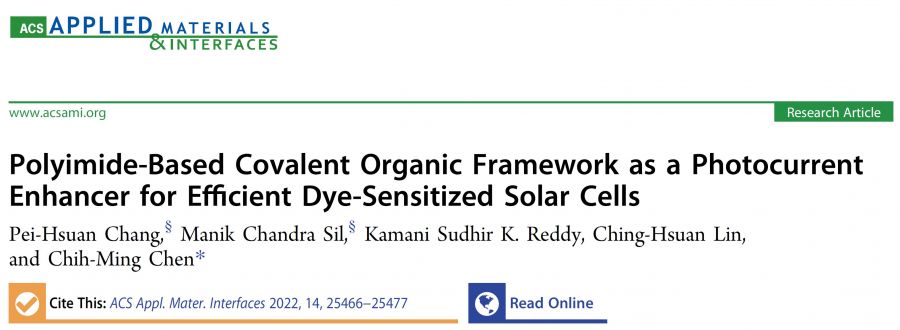設施農業:節能栽培與滅菌【化學工程學系/陳志銘特聘教授】
| 論文篇名 | 英文:Polyimide-based covalent organic framework as a photocurrent enhancer for efficient dye-sensitized solar cells 中文:以聚醯亞胺共價有機框架作為高效染料敏化太陽能電池的光電流增強劑 |
| 期刊名稱 | ACS APPLIED MATERIALS & INTERFACES |
| 發表年份,卷數,起迄頁數 | 2022, 14, 25466–25477 |
| 作者 | Chang, Pei-Hsuan; Sil, Manik Chandra; Reddy, Kamani Sudhir K.; Lin, Ching-Hsuan; Chen, Chih-Ming(陳志銘)* |
| DOI | 10.1021/acsami.2c04507 |
| 中文摘要 | 共價有機框架擁有高孔隙率、優異的熱穩定性和高度有序的共軛結構,有利於電荷遷移、電荷分離和光收集,在能源和光電領域引起極大的興趣。本研究通過均苯四甲酸二酐與三(4-氨基苯基)胺的縮合反應合成聚醯亞胺共價有機框架(PI-COFs),並將其摻雜到染料敏化太陽能電池的TiO2光電極中與 N719 染料合作探索其功能。作為基準,沒有摻雜 PI-COF 的原始染料敏化太陽能電池在模擬太陽光照下表現出 9.05% 的光電轉換效率。0.04 wt% PI-COFs的摻雜有助於提高短路電流密度從 17.43 增加到 19.03 mA/cm2,電池效率提高到 9.93%。短路電流密度的增強歸因於 PI-COFs 的雙功能性,它增強了電荷轉移/注入並通過主體(PI-COF)-客體(N719 染料)相互作用抑制電荷重組。此外,PI-COFs 還具有共敏劑的作用,並在陽光照射下貢獻少量的光生電子。氧等離子體的表面改性提高了 PI-COF 顆粒的親水性並加強了 PI-COF 和 TiO2之間的異質連接,提升電荷注入效能。冠軍電池表現出10.46%的光電轉換效率和19.43 mA/cm2的增強短路電流密度。這種通過在TiO2 奈米顆粒中摻雜 PI-COF 修飾光電極提高太陽能效率的方法在染料敏化太陽能電池的開發中具有前景。 |
| 英文摘要 | Covalent organic frameworks (COFs) are of great interest in the energy and optoelectronic fields due to their high porosity, superior thermal stability, and highly ordered conjugated architecture, which are beneficial for charge migration, charge separation, and light harvesting. In this study, polyimide COFs (PI-COFs) are synthesized through the condensation reaction of pyromellitic dianhydride (PMDA) with tris(4-aminophenyl) amine (TAPA) and then doped in the TiO2 photoelectrode of a dye-sensitized solar cell (DSSC) to co-work with N719 dye to explore their functionality. As a benchmark, the pristine DSSC without the doping of PI-COFs exhibits a power conversion efficiency of 9.05% under simulated one sun illumination. The doping of 0.04 wt % PI-COFs contributes an enhanced short-circuit current density (JSC) from 17.43 to 19.03 mA/cm2, and therefore, the cell efficiency is enhanced to 9.93%. The enhancement of JSC is attributed to the bifunctionality of PI-COFs, which enhances the charge transfer/injection and suppresses the charge recombination through the host (PI-COF)–guest (N719 dye) interaction. In addition, the PI-COFs also function as a cosensitizer and contribute a small quantity of photoinduced electrons upon sunlight illumination. Surface modification of oxygen plasma improves the hydrophilicity of PI-COF particles and reinforces the heterogeneous linkage between PI-COF and TiO2 nanoparticles, giving rise to more efficient charge injection. As a result, the champion cell exhibits a high power conversion efficiency of 10.46% with an enhanced JSC of 19.43 mA/cm2. This methodology of increasing solar efficiency by modification of the photoelectrode with the doping of PI-COFs in the TiO2 nanoparticles is promising in the development of DSSCs. |
| 發表成果與本中心研究主題相關性 | 合成新穎的共價有機框架材料,顯著提升太陽能電池光電效能。 |







